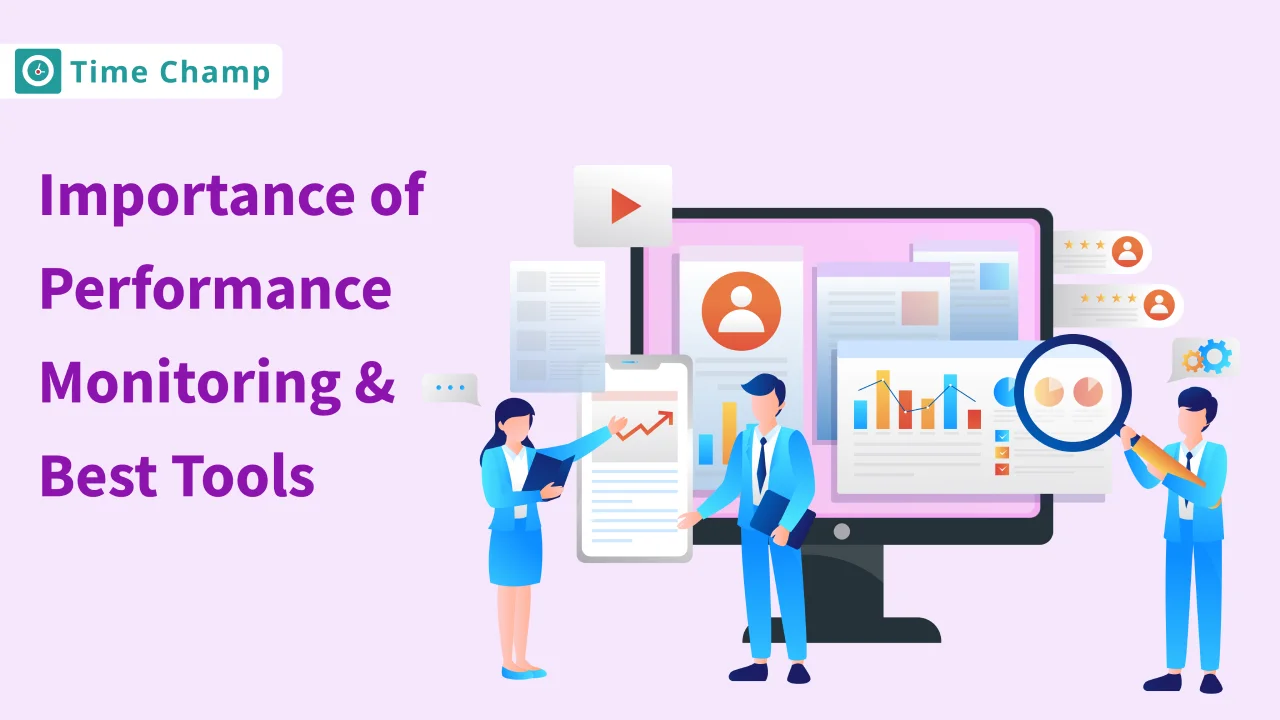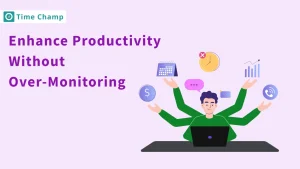In workplaces today, keeping an eye on how employees do their jobs isn’t just something we do out of habit – it’s really important. Imagine that you are driving a super-fast train and you want it to reach its destination without any hiccups. Monitoring employee performance is like making sure every part of that train works perfectly. Let’s dive into why performance monitoring matters so much.
What is Employee Performance Monitoring?
Performance monitoring is a way of keeping an eye on how well things are working. It involves regularly observing and evaluating how individuals or teams perform their tasks within an organization. It’s like keeping track of how smoothly a machine operates to ensure efficiency.
For instance, a retail store may monitor sales staff by setting sales targets and tracking their performance against these goals. If someone consistently falls short, additional support or training may be provided. Conversely, if someone exceeds targets, they may be recognized or given additional responsibilities.
This monitoring process helps identify strengths and areas for improvement and also provides insights into what needs to be done in the future, ultimately optimizing performance and achieving organizational goals.
What is the Importance of Employee Performance Monitoring?
Performance monitoring is crucial in today’s fast-paced world. Here are some key factors to consider when monitoring performance.
1. Data-Driven Decision Making
Monitoring employee performance provides valuable data that can inform strategic decision-making within the organization. By analysing performance metrics, trends, and patterns, managers can make wise decisions regarding resource allocation, staffing levels, and strategic initiatives. This data-driven approach makes sure that decisions are based on facts rather than personal opinions. This helps in achieving better results in the end.
2. Risk Management
Monitoring employee performance helps identify and manage potential risks to the organization. By identifying areas of underperformance or compliance issues early on, managers can take proactive measures to address them before they escalate into larger problems. This proactive approach minimizes the risk of costly errors, legal liabilities, or reputational damage.
3. Alignment with Customer Needs
Employee performance monitoring ensures that employee’s efforts are aligned with customer needs and expectations. By tracking key performance indicators related to customer satisfaction and feedback, organizations can identify areas for improvement in product quality, service delivery, or customer support. This alignment helps organizations maintain a competitive edge in the market and build long-term customer relationships.
4. Promotion of Fairness and Justice
Performance monitoring promotes fairness and justice within the organization by ensuring that employees are evaluated based on objective criteria. Organizations minimize biases and favouritism in performance evaluations by establishing clear performance standards and metrics. This promotes a culture of fairness and transparency, where employees feel confident that their contributions will be recognized and rewarded based on merit.
5. Adaptability and Flexibility
In today’s fast-paced business environment, organizations need to be adaptable and flexible to respond to changing market conditions and customer demands. Employee performance monitoring enables organizations to identify emerging trends and adapt their strategies and processes accordingly. By monitoring performance indicators in real time, organizations can quickly modify and adjust their approach to stay ahead of the competition.
6. Employee Well-being and Satisfaction
Performance monitoring, when conducted in a supportive and constructive manner, contributes to employee well-being and job satisfaction. By providing regular feedback, coaching, and recognition, organizations show their commitment to employee development and success. This, in turn, promotes a positive work environment where employees feel valued, motivated, and engaged in their work.
7. Legal and Regulatory Compliance
Performance tracking and monitoring help organizations ensure compliance with legal and regulatory requirements governing employee performance and conduct. By tracking performance metrics related to compliance standards, Organizations can spot and deal with possible problems before they lead to legal trouble or fines from regulators. By being proactive, they show that they’re dedicated to following the rules and doing business ethically.
8. Recognition and Rewards
Performance tracking and monitoring provide a basis for recognizing and rewarding high-performing employees. By identifying individuals who consistently exceed performance expectations, organizations can acknowledge their contributions and provide incentives to encourage continued excellence. This recognition not only motivates high performers but also sets a positive example for other employees, driving a culture of excellence and achievement.
9. Development of a Learning Culture
Performance tracking and monitoring encourage a culture of continuous learning and development within the organization. By providing employees with regular feedback and opportunities for improvement, organizations create an environment where individuals are motivated to enhance their skills and knowledge. This commitment to learning not only benefits individual employees but also strengthens the organization’s overall capabilities and competitiveness.
10. Identification of Training Needs
Employee performance tracking and monitoring help identify training and development needs across the organization. By analysing performance data, managers can pinpoint areas where employees may require additional training or skill development to perform their roles effectively. This proactive approach to training ensures that employees have the necessary knowledge and skills to excel in their positions, ultimately driving improved performance and productivity.
How To Measure Employee Performance?
Every job involves different duties and tasks, so the requirements for evaluating employee performance vary based on the type of business and its operations. However, typically, the main ways to measure performance are.
- Set Clear Expectations: Define clear goals and expectations for each employee using SMART criteria (Specific, Measurable, Achievable, Relevant, Time-bound).
- Use Key Performance Indicators (KPIs): Identify relevant KPIs aligned with organizational goals, such as sales targets, productivity levels, and customer satisfaction scores.
- Provide Regular Feedback and Coaching: Offer constructive feedback and coaching to help employees understand their performance and improve.
- Conduct Performance Reviews: Schedule regular performance reviews to assess progress, set new goals, and plan for development opportunities.
- Gather 360-Degree Feedback: Collect feedback from multiple sources, including peers, subordinates, and managers, to gain a comprehensive view of performance.
- Leverage Performance Management Systems: Utilize performance management software to streamline performance evaluation processes and track performance data efficiently.
- Focus on Continuous Improvement: Regularly review and adjust performance goals and feedback mechanisms to ensure they remain relevant and supportive of business objectives.
What are the Benefits of Monitoring Employee Performance?
There are many benefits of monitoring employee performance for both employees and organizations. Here are some of the key benefits of monitoring performance.
- Clear Expectations: Performance tracking and monitoring help set clear expectations by defining specific goals and objectives for employees. This clarity enables employees to understand what is expected of them, reducing confusion and enhancing productivity.
- Feedback and Improvement: Regular monitoring provides employees with feedback on their performance, highlighting areas of strength and areas for improvement. This feedback loop allows employees to make necessary adjustments, learn from mistakes, and continuously improve their performance.
- Accountability: Monitoring performance holds employees accountable for their work. When employees know that their performance is being tracked, they are more likely to stay focused and motivated to meet their goals.
- Recognition and Rewards: Monitoring performance allows managers to recognize and reward employees for their achievements. Positive reinforcement boosts morale, increases motivation, and fosters a positive work environment.
- Identifying Training Needs: By monitoring performance, managers can identify areas where employees may need additional training or support. Addressing these training needs improves employee skills and enhances overall performance.
- Resource Allocation: Performance tracking and monitoring helps organizations allocate resources effectively. By identifying high-performing employees and areas of improvement, organizations can allocate resources where they are needed most, maximizing efficiency and productivity.
- Goal Alignment: Monitoring performance ensures that employee efforts are aligned with organizational goals. When employees understand how their work contributes to the overall success of the organization, they are more engaged and committed to achieving those goals.
- Data-Driven Decisions: Performance monitoring provides valuable data that can inform strategic decision-making. By analyzing performance metrics, organizations can identify trends, measure progress, and make informed decisions to drive business success.
Best Practices for Monitoring Employee Performance
- Make sure to keep an eye on how your application is doing, gather lots of information, and use instant alerts to improve its performance.
- Always focus on what your users need to make sure they have a great experience.
- Allow different parts of your software to talk to each other using a specific set of rules and methods called an API (Application Programming Interface).
- Whenever there’s a problem, carefully look into it by checking the logs and data.
- Improve your program’s code, test it well, and make sure it’s secure.
- Share what you know with your team to solve problems together and keep an eye on things.
- Measure things like how fast your API responds, how often it has errors, and how much traffic it handles.
- Understand what’s important to monitor for your API to work well.
- Keep an eye on the logs to see what’s happening and fix any issues.
- Keep an eye on how much your computer’s processor and memory are being used to make sure your API runs smoothly.
- Make sure your API responds quickly to keep users happy.
- Test your final product to make sure it’s as safe as possible before letting users access it.
- Security and privacy concerns with performance tracking and monitoring
Ensuring Security and Data Privacy While Monitoring Employee Performance
- Make sure to keep an eye on how your application is doing, gather lots of information, and use instant alerts to improve its performance.
- Always focus on what your users need to make sure they have a great experience.
- Allow different parts of your software to talk to each other using a specific set of rules and methods called an API.
- Whenever there’s a problem, carefully look into it by checking the logs and data.
- Improve your program’s code, test it well, and make sure it’s secure.
- Share what you know with your team to solve problems together and keep an eye on things.
- Measure things like how fast your API responds, how often it has errors, and how much traffic it handles.
- Understand what’s important to monitor for your API to work well.
- Keep an eye on the logs to see what’s happening and fix any issues.
- Keep an eye on how much your computer’s processor and memory are being used to make sure your API runs smoothly.
- Make sure your API responds quickly to keep users happy.
- Test your final product to make sure it’s as safe as possible before letting users access it.
Top 5 Employee Performance Monitoring Tools
1. Time Champ
Time Champ offers a wide range of features for businesses looking for efficient and effective employee performance monitoring software. Here are some of the key features that help you effortlessly monitor your employee performance.
- Time Tracking: Time tracking allows you to track employee working hours accurately to optimize time management. Ensure compliance with labor regulations and accurately bill clients or projects based on tracked hours.
- Activity Monitoring: Activity Monitoring allows users to monitor real-time employee activities to gauge productivity levels and identify potential distractions. Gain insights into application usage patterns and time spent on different tasks to improve overall efficiency.
- Productivity Analysis: Analyze productivity metrics to identify trends and areas for improvement. Compare these performance metrics across teams or individuals to recognize top performers and provide targeted support where needed.
- Task Management: Simplify task allocation, deadline setting, and progress tracking for effective task management. Enhance collaboration among team members by assigning tasks, setting priorities, and tracking progress in one centralized platform.
- Customizable Reports: Generate custom reports on employee performance and productivity metrics for data-driven decision-making. Customize report parameters to focus on specific metrics or time periods, providing actionable insights for optimizing workflows and resource allocation. Sign up now to get !
2. ActivTrak
- ActivTrak offers employee monitoring and productivity tracking features.
- Provides insights into employee activity, application usage, and website visits.
- Features real-time monitoring, automated alerts, and productivity analysis.
- Helps organizations improve efficiency, identify bottlenecks, and optimize workflows.
3. Time Doctor
- Time Doctor specializes in time tracking and productivity management for remote teams.
- Tracks time spent on tasks, websites, and applications to improve time management.
- Offers features such as screenshots, activity tracking, and distraction alerts.
- Helps organizations increase productivity, accountability, and transparency in remote work environments.
4. Teramind
- Teramind offers solutions for employee monitoring, detecting insider threats, and preventing data loss.
- Offers real-time monitoring of user activity, including keystrokes, emails, and file transfers.
- Features behavior analytics, anomaly detection, and risk scoring for proactive threat detection.
- Helps organizations protect sensitive data, prevent insider threats, and ensure compliance with regulations.
5. Hubstaff
- Hubstaff offers time tracking, employee monitoring, and project management features.
- Tracks time spent on tasks, projects, and client work for accurate billing and payroll.
- Features GPS tracking, activity monitoring, and productivity analysis for remote teams.
- Helps organizations improve productivity, accountability, and project transparency.
Optimize employee performance monitoring and achieve exceptional results with Time Champ!
Signup for FreeBook DemoConclusion
In conclusion, it is important to monitor employee performance for businesses to keep track of how well their systems, applications, and employees are performing. It helps in ensuring smooth operations, identify areas for improvement, and ultimately, makes it easier for both the company and employees to improve and achieve their goals. By utilizing the best performance tracking and monitoring tools available, businesses can gain valuable insights, optimize productivity, and stay competitive in today’s dynamic environment.
Try out effective performance monitoring features and get detailed insights into your employee productivity-Book your free demo now!
Frequently Asked Questions
Performance tracking and monitoring helps businesses track how efficiently their systems, applications, and employees are performing. It ensures that operations run smoothly, identifies bottlenecks, and allows for timely intervention to maintain productivity and meet organizational goals.
Performance tracking and monitoring tools provide real-time insights into system performance, application uptime, and employee productivity. They help businesses optimize resource usage, detect issues before they escalate, and make data-driven decisions to improve overall efficiency.
Performance tracking and monitoring tools enable businesses to track employee activities, identify inefficiencies, and provide feedback for improvement. By analyzing productivity metrics, businesses can identify top performers, address workflow bottlenecks, and optimize task allocation for better results.
Key features to consider in performance tracking and monitoring software include real-time monitoring capabilities, customizable dashboards and reports, integration with other systems, scalability to accommodate growth, and robust security measures to protect sensitive data.
Performance tracking and monitoring contribute by ensuring smooth system operation, leading to improved customer experiences by minimizing downtime and ensuring fast response times.
These tools provide insights into system performance, helping businesses identify and resolve bottlenecks by analysing metrics like response times and resource usage.
Performance tracking and monitoring tools prioritize data security and privacy through encryption protocols, access controls, and compliance measures, safeguarding sensitive data.
Yes, they offer scalable solutions adaptable to businesses of all sizes, providing valuable insights and optimizing performance across different organizational levels.







